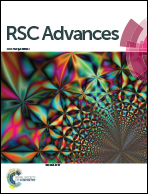Enhancement of oxygen reduction reaction performance of Pt nanomaterials by 1-dimensional structure and Au alloying†
Abstract
The effect of aspect ratios and Au alloying on the ORR performance of carbon-supported Pt nanorods (NRs) is investigated. The ORR activity of PtAu NRs after durability tests shows excellent stability due to the modification of electronic structure and surface composition.


 Please wait while we load your content...
Please wait while we load your content...